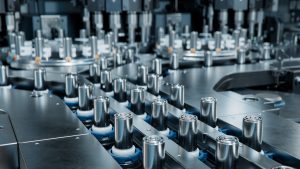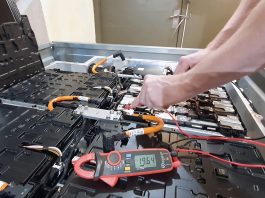Sean De Vries, from the Battery Metals Association of Canada, debunks the myths of declining EV sales and highlights the promising investments and developments that indicate Canada’s strong position in the global battery metals industry.
With a solid foundation of resources and expertise, as well as support from strategic investment by the government and private sector, Canada’s battery metals sector has flourished in recent years. While recent concerns have surfaced about the deceleration of the EV market due to various economic factors and infrastructure availability, the reality seems to indicate cause for optimism.
The Battery Metals Association of Canada (BMAC) brings together the entire supply chain of Canada’s battery metals sector. BMAC is committed to supporting Canada’s rapidly evolving energy landscape and enabling the country to fully leverage its abundant resources. By promoting research and development and fostering collaboration, BMAC aims to expand the domestic supply chain and position Canada as a global leader in driving the energy transition.
BMAC is confident that Canada’s battery metals sector remains strong and continues to hold significant potential. To highlight the extensive developments currently taking place across the minerals and battery value chains, The Innovation Platform Editor Maddie Hall spoke with BMAC’s Sean De Vries.
What is the current outlook for battery metals in Canada? Despite recent concerns, why should we be optimistic about the EV market?
Despite the prevailing doom-and-gloom stories, the numbers clearly indicate a continuous growth in the sale of electric vehicles (EVs) as well as the battery capacity entering the market. Thus, the demand for critical materials shows no signs of slowing. According to Adamas Intelligence, there has been a 12% month-over-month growth in EV sales and a 22% year-over-year growth from the beginning of the year until May. These figures point to a substantial and ongoing expansion in the market, which is likely to increase further.
Are EV sales the main driver behind this growth?
While EV sales significantly impact the demand for critical minerals, they are not the only drivers behind the growth. Canada also has a strong energy storage market developing, largely because it is fortunate to have abundant supplies of clean energy, including hydroelectric and nuclear power. The main challenge now is how to effectively capture excess energy created during low consumption periods and store this energy for later use during peak times.
Energy storage is essential for balancing and ensuring grid reliability, and it goes hand in hand with renewable energy generation. Significant advancements have been made in both fields, and we are seeing more of these developments taking place in partnership, particularly as wind and solar become increasingly larger contributors to the overall energy picture.
Which battery energy storage technologies are currently most prevalent in Canada?
Lithium-ion batteries have become the leading technology in the current market landscape owing to their superior performance and energy storage capabilities.
However, it’s important to acknowledge that future developments could lead to the emergence of alternative battery chemistries, such as sodium or zinc-based systems. The decision on which battery technology to pursue will likely be influenced by factors such as mineral availability, extraction costs, and overall capacity.

Despite these potential advancements, lithium-ion batteries currently remain the predominant choice for a wide range of applications due to their proven reliability and versatility.
Can you discuss some of the industry developments happening across the battery metal supply chain?
There is currently a flurry of activity across the entire value chain, but many of these developments appear to be happening in isolation. At BMAC, our primary focus is to help bring together these individual projects to facilitate the development of a comprehensive battery ecosystem that incorporates all segments of the battery value chain and provides opportunities right across Canada.
Although Canada is rich in critical minerals, which provide significant opportunities for development, the processing capacity for these minerals is lacking. To address this gap, a crucial next step is to develop processing facilities that can domestically transform these minerals into battery-grade materials to avoid having to export them for processing. There is progress in this area, with announcements that pre-CAM and CAM facilities are capable of creating these materials, but those developments are still underway.
Furthermore, multiple battery gigafactories have been announced, and they present significant opportunities for the rest of the value chain by creating a demand for the minerals and other components. Although these facilities are still in development, they will take us one step closer to bridging the gap in processing capacity and completing Canada’s battery supply chain.
How has the government supported the growth and development of the battery metals sector?
There has been strong support for the industry from various levels of government right across Canada. Starting with the federal Electric Vehicle Availability Standard that will require 100% of passenger vehicle sales in 2035 to be zero-emission vehicles, the government has created significant domestic market demand for EVs and batteries.
In addition, substantial investment has been made across the entire value chain, with significant projects taking place in each segment. The objective now is to integrate these projects and establish a comprehensive battery ecosystem rather than isolated initiatives, and BMAC is working to identify where these investments will have the most impact, both in terms of the types of operations that are best suited for the industry in Canada and the ideal locations to support those developments.
This investment and incentivisation complement the regulation and framework established by the Canadian Government to develop comprehensive supply chain capabilities.
How is BMAC looking to support and expand Canada’s battery metals industry?
BMAC is focusing on a few key areas. First, we are working with industry experts to identify the ideal mineral processing operations that can be implemented in Canada to enable the processing of key materials in a competitive and low-carbon manner.
Second, we are exploring opportunities for battery hubs in Western Canada that can support the hubs in Ontario and Quebec. For example, with the enormous potential of the lithium-brine projects underway in Western Canada, we will examine how those resources and existing assets, infrastructure, and skills can be leveraged to support the development of integrated industry clusters or hubs. Rather than replicating existing operations in the East, this will consider which regions are best suited for particular projects or purposes, ideally addressing gaps in the overall ecosystem.
Finally, we are supporting organisations right across the value chain in better understanding the need for early engagement with Indigenous communities and stakeholders to ensure they are included in projects in meaningful ways, right from the early development stages. The goal is to find pathways to build strong relationships and partnerships between Indigenous communities and industry to design projects in a way that meets the needs of each.
Ultimately, we are trying to build the case for smart and strategic development while identifying areas of untapped potential that could be the key to scaling up Canada’s battery metals operations.
Are there any parallels that can be drawn between the current developments in the mining to energy metals sectors in Canada with other sectors or past developments? What lessons can they provide?
Interestingly, although the energy transition is about replacing fossil fuels with renewables, in the development of this new clean energy industry, much can be learned from another significant energy development in Canada – the Alberta oil sands.
The development of the oil sands required significant industry and government collaboration in areas such as research and development, project approvals, and funding. It also required the inclusion and support of local communities, particularly Indigenous communities, to integrate their perspectives into the developments. Technological innovation was also pivotal in making extraction from the oil sands feasible and economically viable.
We can draw parallels to similar requirements for success in the extraction of critical minerals and the approval of related projects. Canada has done this before and, with a concerted focus on collaboration, inclusion, and innovation, can once again build a solid foundation for these new industrial developments.
What are the primary challenges to the battery sector’s development, and how is Canada positioned to overcome these challenges?
Canada is well-positioned to overcome the challenges facing the battery sector’s development despite China’s current dominance in the mineral and EV markets. While China controls a significant portion of the global lithium-ion battery supply chain and EV production, Canada’s abundant natural resources, strategic partnerships, and commitment to sustainable practices offer a compelling alternative.
Canada possesses all the necessary pieces to develop a battery value chain and must now bring these together to bolster its competitiveness as an alternative value chain. Our international collaboration is a considerable asset. Canada’s automotive industry is highly integrated with that of the US and is able to capitalise on the large US market so close by.
The aforementioned industry and government collaboration is also crucial. These initiatives, investments, and clean energy tax breaks support the sector’s development and create a business-friendly climate for organisations to thrive. Canada’s human capital, in regard to its extensive skill sets and knowledge of mineral exploration, chemical engineering, and manufacturing, is another significant advantage, setting it above other locations.
Thanks to the country’s long history of mining, minerals processing, and manufacturing, the workforce is highly skilled, with many opportunities for industry transfer and redeployment.
Not only is Canada capable of producing a high-value battery supply chain, but it is also determined to achieve this in a clean, low-carbon manner, which will set it apart from current competitors.
Innovation will be directed at comprehensive decarbonisation across the industry, and the processing capacity will be developed to allow us to complete the domestic supply chain. Canada is set to have a considerably strong market not just for batteries and minerals but for the entire EV and green energy supply chains, truly cementing its future as a global leader.
Please note, this article will also appear in the 19th edition of our quarterly publication.









